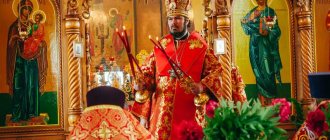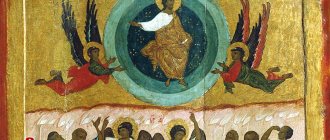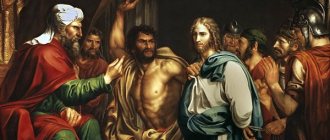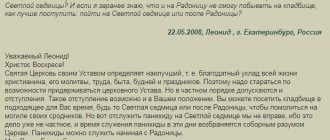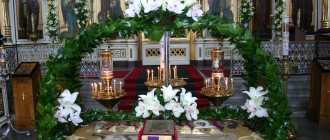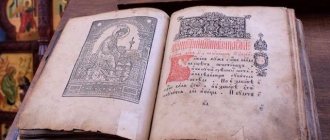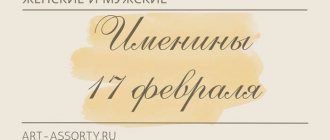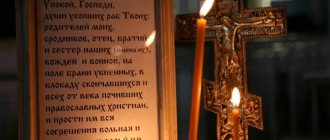Easter is the oldest Christian holiday celebrated in honor of the resurrection of Jesus Christ. Symbolizes the victory of life over death. Transitional is celebrated annually according to the lunar calendar. The week after Easter is called Bright Week (Red). The Orthodox consider these 7 days to be special; all of them should be spent cheerfully, rejoice, and drive away bad thoughts from yourself. It is advisable not to work, but to rest your soul and body, because this was preceded by Lent, full of hardships, restrictions and strict rules of life.
Week 2 – St. Thomas the Apostle. Antipascha
Antipascha (from the Greek ἀντι - instead of, opposite - Easter) is the first Sunday after Easter, otherwise called the Week of Thomas, or St. Thomas Sunday.
The service of this day is associated with the remembrance of two appearances of the Risen Lord Jesus Christ to the apostles - on the evening of Bright Resurrection itself (to the ten apostles, Apostle Thomas was absent) and after eight days to the eleven apostles, among whom was the Apostle Thomas, who said before: if I do not see Him in His arms I will not put my finger into the print of the nails, nor will I put my hand into His side, I will not believe (John 20:25). This appearance of Christ to the apostles and the touching of his wounds by the Apostle Thomas confirms faith in the truth of the Resurrection of Christ and recalls the covenant of the Savior Himself: blessed are those who have not seen and have believed (John 20:29). And it also testifies to the power of Him for Whom there are no barriers either in closed doors or in any human power.
On the week of Antipascha, during the divine service we hear the troparion: Thou didst appear to the sealed tomb, the belly from the tomb, O Christ God, and to the closed door, thou appeared as a disciple, the Resurrection of all, renewing the Right Spirit to us by those, according to Thy great mercy.
Do's and Don'ts in the week after Easter
Allowed:
- ring bells, give alms;
- help those in need;
- rejoice, have fun, laugh, be happy;
- to be baptized;
- relax, enjoy life, postponing urgent matters for later;
- give up negative actions and thoughts;
- on Friday to bless the water and honor the Blessed Virgin;
- arrange shows;
- light fires, relax in nature, ride on a swing.
Forbidden:
- get married;
- visit the dead in the cemetery, perform wakes and memorial services;
- work hard, especially on Wednesday;
- fast;
- stay at home on Sunday;
- hunt and fish, since everyone rejoices at the miraculous resurrection of the Savior, even animals and birds: they are also creatures of God.
Customs, signs, rituals for the days of Bright Week
Easter week, the first week after Easter, determined what the summer would be like: clear weather foreshadowed heat and a good harvest.
In the bright days after the Resurrection of Christ, people swung on a swing to get rid of sins: one swing - minus a bad deed or a bad thought. “Blows away with the wind,” people said, “all sins, big and small.”
In all the temples, the doors were open as a symbol of the open road to heaven for everyone. The Risen Savior gave this road to his children.
A baby born on Easter week was doomed to a long life and good health. All days of the week after Easter were called Bright days
Week 3 – Holy Myrrh-Bearing Women
On this Sunday, the Church remembers the holy myrrh-bearing women: Mary Magdalene, Mary of Cleopas, Salome, Joanna, Martha and Mary, Susanna and others, as well as the righteous Joseph of Arimathea and Nicodemus - the secret disciples of Christ. With the divine service of this day, the Church again places us on Golgotha at the Cross of Christ, from which Joseph and Nicodemus remove His Most Pure Body, and in Vertograd at the tomb, where they lay the Body of Jesus Christ and where then the myrrh-bearers, who came to anoint the Body with fragrant oils, are the first to be rewarded with seeing the Risen One Lord (Mark 15:43-46;16:1-8). The Gospel shows us that faith and zeal do not go unrewarded - the grace of God precedes those who seek God.
Following the example of the holy myrrh-bearing women, we must kindle in our hearts true self-sacrificing love for our Savior, so that, as the Apostle says (Rom. 8:38-39), nothing can separate us from Him - neither the present nor the future, neither life nor death, neither angels nor men. In addition, just as the holy women, wounded by fierce sorrow at the sight of the crucified Lord, sought and found consolation in His tomb, so every Christian soul should seek consolation in sorrows and sorrows at the tomb and cross of its Savior.
Glorifying the myrrh-bearing women, the Church glorifies them with the words of the troparion: An angel appeared to the myrrh-bearing women at the tomb, crying: peace is fitting for the dead, but Christ has appeared alien to corruption. But cry: the Lord is risen, grant great mercy to the world.
Orthodox customs
Among Christian believers, almost all the customs of Bright Week are still alive:
- Throughout Easter week, church services are held; the altar and deacon's gates are kept open, symbolizing the gates of the Kingdom of Heaven, opened by Christ for all Christians.
- In large churches, after the service, religious processions are held, at which time round bread - artos - with symbols of the torment of Christ is carried around the church: a cross with a crown of thorns. After the consecration, the bread was distributed to the believers.
- The priests organized a festive solemn procession through all the villages of their parish, starting from the church of the central settlement. The column began with the God-bearers, carrying banners with icons, followed by the clergy, and as the procession progressed, people joined the procession. A tour of a large parish could take several days. Believers walked from courtyard to courtyard, each had a priest serving a prayer service, and residents presented guests with Easter cakes and Easter eggs.
- Throughout the week, believers should not just read prayers before going to bed, but offer praise to our Lord Jesus Christ and the Mother of God. Next to the icons they placed a small jug of honey, as well as two candles that burned until the morning as a sign of remembrance of the dead.
- Chants with prayers during Easter week were considered to protect against misfortunes; they guaranteed prosperity and a strong economy.
It is believed that Christ rejoices with everyone and gives grace.
In addition to observing these traditions, during Easter week they also commemorate the dead. This happens twice: on Monday and Thursday. These events are not considered sad at all and do not contradict the festive mood. Believers believe that the souls of the dead returned to the living to enjoy the holiday together these days, hoping for their resurrection. Commemoration of the dead occurs only in the cemetery, where food is left on the graves, subsequently collected by passing beggars.
On such days, it is forbidden to wash and sew, otherwise you can muddy the water in front of the dead or sew up their eyes.
Week 4 – about the relaxed
On this day, the Gospel passage about the miraculous healing of the paralytic by the Lord is read in churches. He was ill for 38 years and waited for deliverance from it near the pool, in which once a year the first person who entered it was healed (John 5:1-14).
This bath was a prototype of the font of Baptism given by Christ, in which, more than once a year, but at any hour, every believer can be healed, cleansing himself from the filth of sin, and be born for a new life. The five covered passages leading to the pool symbolize the five Books of Moses leading to salvation, that is, the Jewish Scriptures, which, according to the word of the Savior Himself, testify about Him (John 5:39). Accordingly, the many sick people lying around the pool represent the image of fallen humanity stricken by sin, awaiting the coming of the Messiah and salvation.
The Gospel of the Paralytic allegorically tells us about the disease of spiritual relaxation. Such relaxation usually comes from despair or laziness and despondency, but it is important to remember that the slightest effort and patience made by a believer in such a situation will not be in vain, since the Lord is all-seeing, and at a moment known to Him He will certainly stretch out His right hand and say: “Stand up.” and go"! It is important to remember that the salvation of people is impossible without some effort on the part of the people themselves, for the Kingdom of Heaven is taken by force, and those who use force take it away (Matthew 11:12).
Kontakion of the Feast: O Lord, my soul, weakened by all sorts of sins and unplaceable deeds, raise up through Your Divine intercession, just as You raised up the weakened one of old, so that I call You to save: Generous, glory to Christ, Your power.
On Wednesday of the 4th week, Mid-Pentecost is celebrated, that is, half the time from Easter to Pentecost. Midsummer connects the two greatest Christian holidays - Easter and the Descent of the Holy Spirit. On this day, an event from the life of Christ the Savior is remembered, when, at the Midsummer of the Old Testament Feast of Tabernacles, He taught in the temple about His Divine Messenger and about the mysterious water, which means the grace-filled teaching of Christ and the grace-filled gifts of the Holy Spirit. This water is spoken of in the troparion of the Midsummer: I am halfway through the holiday, and give water to my thirsty soul for piety, as you cried out to everyone, O Savior: thirst, let him come to me, and let him drink. Source of our life, Christ God, glory to Thee.
Games and fun
Throughout the entire Bright Easter week, people had fun, every day they went to visit, gathered with loved ones for a festive meal, and then sang, danced, danced in circles, had fun in every way, and were simply happy. Among the common Easter fun, unfortunately lost or forgotten today:
- Round dances, which were led by people holding hands, changing the direction and pace of movement to musical accompaniment or choral chants.
- Egg rolling. All participants place their colored eggs in a semicircle near a low slide or on an inclined surface, after which one of them rolls his egg on top, trying to knock down as many of the others as possible. The player takes all the beaten eggs for himself, but if nothing works out, then he loses his own. Participants had to beautifully and originally paint their eggs so that they could be easily distinguished from others. By the way, this tradition comes from pagan times, where it was called upon to awaken the forces of the earth and ensure a good harvest.
- Bride's choice.
The girls stood in pairs one after another, and a young man walked along the resulting “corridor”, who was supposed to take away the girl he liked. Then, without letting go of his chosen one, he learned from his friends about her merits; if, after hearing this, the young man kissed the girl, then they remained a couple until the end of the holiday festivities. - Swing. This fun was one of the most favorite during the holidays. The youth swung on the swings, and the rest of the people watched. Often the rides were accompanied by cheerful and playful chants, often with a hint of imminent matchmaking. The girls always occupied the swings first, and the guys either rocked them or sat next to them. The girls thanked their gentlemen for swinging, giving them colored eggs.
By the way, it was believed that while riding on a swing, the wind would blow away sins from a person.
Week 5 – about the Samaritan
This week the Church offers us a conversation between Jesus Christ and the Samaritan woman, in which He clearly confessed Himself to be the Messiah (John 4:5-42). With His gracious word, the Lord, who supplies “living water that dries up the fountains of sins” (canon of the week), leads the Samaritan woman, and through her many Samaritans, to confess His Divine greatness and returns them to the true path.
According to legend, the woman whom the Lord met at the well bore the name Photina (Svetlana). She became a Christian and accepted martyrdom for Christ in Rome in 66. Kontakion of the feast: By faith the Samaritan woman, who came to the well of wisdom, saw the water of Thy wisdom, and drank abundantly from it, will inherit the Kingdom on High forever, as she is ever glorious.
Week 6 – about the blind man
This holiday reminds us of the Lord’s healing of a man born blind, described in the Gospel (John 9:1-38).
Using the example of a man born blind, healed by Jesus Christ, the Holy Church presents the image of every sinner who is blind from birth, because all have sinned and fall short of the glory of God (Rom. 3:23), and by the granting of sight to the eyes of the blind, she teaches that the true enlightener is the Lord alone , “Giver of Light, from the Light is this Light” (Synaxarion of the week), and only in this Light can truth and salvation be seen.
Kontakion of the holiday: Blinded by my spiritual eyes, I come to You, Christ, as if blind from birth, I call You with repentance: You are the Most Bright Light of those who are in darkness.
How to prepare at home for Easter week 2022
The entire Great Lent and Holy Week are preparations for the Bright Resurrection of Christ and Easter Week.
There is no rule established by the Orthodox Church that on Maundy Thursday you need to paint eggs and bake Easter cakes. This is one of the biggest misconceptions, comparable only to the religious significance of Thursday salt. There are extremely well-established folk customs and a popular idea about black salt, which is supposedly prepared during Holy Week on Maundy Thursday at the church, and then distributed at the service.
Coloring eggs and baking Easter cakes used to be done starting from Maundy Thursday, since this was associated with certain difficulties in the technology of preparing dishes and with their large volume. Now you can cook Easter dishes on both Friday and Saturday. To help cooks, there are small household appliances and a stove that bakes without pre-heating for a long time. There are no restrictions on “rights”.
During Holy Week there are no special prohibitions or rules for preparing dishes for the festive Easter table. The set depends entirely on the hostess; there is only a mandatory dish - Easter eggs. According to one of the established versions, their obligatory presence is associated with the meeting of Mary Magdalene and Emperor Tiberius, when, after the words: “Christ is Risen!” chicken eggs turned red. Everyone is allowed to paint eggs and prepare Easter treats; there are no restrictions either. Atheists, children, believers can all take part in preparing the holiday.
Interestingly, in our region there are quite a lot of not just interethnic, but also interfaith families. I have never heard of any gastronomic conflicts, but I know a lot of examples when a Muslim wife paints eggs, prepares Easter cheese and bakes Easter cakes.
There is only one general rule regarding the preparation of Easter dishes - everything we do, we do with love. I myself will paint the eggs the old fashioned way - with onion skins. I don’t know what the secret is, but they always seem incredibly tasty to me.
You can bless the prepared dishes starting from Vespers on Great Saturday, at the end of the Easter service on the night from Saturday to Sunday and on the morning of Easter Sunday, that is, on Easter, May 2.
Week 7 – Holy Fathers of the First Ecumenical Council
This week celebrates the memory of the 318 Fathers of the First Ecumenical Council, held in 325 in Nicaea under Emperor Constantine the Great.
His main task was to expose the false teaching of the Alexandrian priest Arius, who rejected the Divinity and the pre-eternal birth of the Son of God from God the Father and taught that Christ is only the highest creation. The heresy of Arius concerned the main Christian dogma, on which the whole faith and the entire Church of Christ is based and which is the only basis for the hope of our salvation.
At the invitation of Saint Constantine, representatives of Christian Churches from different countries gathered in Nicaea. Among those who arrived were many confessors who had suffered during the persecution and bore marks of torture on their bodies. Participants in the Council were also great luminaries of the Church - saints: Nicholas, Archbishop of Myra of Lycia; Spyridon, Bishop of Trimifuntsky; Athanasius the Great, a zealous fighter for the purity of Orthodoxy, who was then a deacon, and other holy fathers revered by the Church.
The Council, as stated in the Synaxarion of the week, preached the Son of God “of the same essence and consummation with the Father” and confessed that He is truly the Son of God and a perfect Man. The result of the Council's labors were the first seven members of the Creed professed by the Orthodox, which was later supplemented at the Second Ecumenical Council.
Troparion to the holy fathers: Glorified art thou, O Christ our God, who founded our fathers as a light on the earth, and taught us all to the true faith, Most gracious, glory to Thee.
***
The series of weeks after Easter ends with the greatest triumph of Christianity - the feast of Pentecost (Trinity), marked by the descent of the promised Comforter of the Holy Spirit on the disciples and apostles of the Lord and the birth of the Church of Christ. That Church about which the Lord said: I will build My Church, and the gates of hell will not prevail against it (Matt. 16:18).
Bright Week (Easter Week) is a holiday week that lasts from Easter to Krasnaya Gorka. It was considered the beginning of spring rebirth, renewal of life. Other names of the week
: Easter, Christovochka (bonfire), Provodnaya (Belarus), Gremyatskaya week (Chernigov), Red week, Red Christmastide, Holy week, Bright, Velikodenskaya, Great, Joyful, Glorious, Grevitskaya week, “Velitsidni” (woodland), “Great Christmastide” (Polish), Bright Week (church).
Rituals of the week
On Easter Week, church services are held daily according to the Easter rite. Morning and evening prayers are replaced by the singing of the Easter hours. After each Divine Liturgy, a festive religious procession is held, symbolizing the procession of the myrrh-bearing women to the tomb of Christ. At the Procession of the Cross, worshipers walk with lit candles. The Royal Doors in the iconostasis (separating the altar from the main space of the temple) remain open throughout Bright Easter Week as a sign that on these days the invisible, spiritual, Heavenly world seems to be opening up before the believers. The open Royal Doors are an image of the Holy Sepulcher, from which an Angel rolled away the stone. During the whole of Bright Week they do not close, even during the communion of the clergy - they close only on Holy Saturday before 9 o'clock. Throughout the entire Week, all bells are rung every day. According to tradition, any lay person, with the blessing of the abbot, can climb the bell tower and ring the bells. On Bright Week, one-day fasts (Wednesday and Friday) are canceled. Starting from the day of Holy Easter, believers greet each other with words of Easter joy: “Christ is risen! “Truly he is risen!” — Before the Feast of the Holy Trinity (on the fiftieth day after Easter), prostrations are not performed. — There are no weddings or funeral prayers on Bright Week. “Funeral services for the dead are held, but more than half of them consist of Easter hymns. Throughout Bright Week, a special bread called artos stands near the open Royal Doors. This custom has been established since apostolic times. It is known that after His resurrection the Lord repeatedly appeared to His disciples. At the same time, He either ate the food Himself or blessed the meal. In anticipation of these blessed visits, and later in memory of them, the holy apostles left the middle place at the table unoccupied and placed part of the bread in front of this place, as if the Lord Himself was invisibly present here. In continuation of this tradition, the Fathers of the Church established the placing of bread in the church on the Feast of the Resurrection of the Lord. During Bright Week, which was considered the beginning of spring rebirth and renewal of life, many ritual actions related to marriages were carried out. Their initiators and main participants were single youth and newlyweds. Spring-summer festivities for boys and girls began with Bright Week. Bright Week was also a time when bride viewings took place in Russian villages. This happened differently in different villages. For example, in the Pechora district of the Arkhangelsk province, girls, wearing the most beautiful outfit, went out onto the rural street to play bacha. The bacha was a long stick decorated with paintings, which was used to knock down a wooden figurine placed on the ground. The game attracted a large number of people who wanted to watch the girls. In the Oryol province, girls, putting on women's clothes for the first time - poneva, went to the meadow to fry eggs and have fun without the participation of boys. In the Ryazan province, girls who had reached marriageable age were invited to the square in front of the church. They stood there for a while for everyone to see, and then rode around the village on horseback. At the same time, they were “offered” as brides to every man they met. During Easter week, girls performed various magical acts aimed at bringing matchmaking and marriage closer. So, dreaming of getting married as soon as possible, the girl had to be the first to get to the bell tower on Great Day and the first to ring the bell. During Bright Week, parades of newlyweds were held in many regions, and rituals were held that consolidated their new social status. In the Vladimir province, for example, newlyweds approached married women gathered at their house and gave them pie and eggs as an “introduction”. In the Kostroma province, married women, gathered in a group, came to the newlyweds’ house and demanded that the newlywed let them in. She opened the door for them and said: “Neighbors, my dears, love and favor me, take me as your friend.” After this, everyone entered the house and treated themselves to festive food. The entire Bright Week was devoted to entertainment: we went to visit each other, treated ourselves to good quick food. However, there were no excesses in food and drink, the great village-wide revelry with fights characteristic of patronal feasts, on these bright days, as people called them. The festive meal was fun, joyful, but at the same time decorous and dignified. On Bright Week, many people gathered on the village streets: they walked, showing off themselves, their children, their outfits, looking at other walkers, and sang songs.
Happy Monday
The Bible tells that, having risen, Christ appeared unrecognized to two of his saddened disciples, shared with them the path to the village of Emmaus, not far from Jerusalem, and dinner. “...He took the bread, blessed it, broke it and gave it to them. Then their eyes were opened and they recognized Him. But He became invisible to them. And they said to each other: Did not our heart burn within us when He spoke to us on the road and when He explained the Scripture to us? And, rising at that same hour, they returned to Jerusalem and found together the eleven Apostles and those who were with them, who said that the Lord had truly risen and appeared to Simon. And they told about what had happened on the way, and how He was recognized by them in the breaking of bread. While they were talking about this, Jesus Himself stood in the midst of them and said to them, “Peace be with you.” According to the Holy Scriptures, on the first day after the resurrection, Jesus appeared to his disciples and for 40 days told them about the Kingdom of Heaven, after which the sky ascended. The abbot performs Vespers on the first day of Easter, dressed in all sacred clothes. After the evening entrance with the Gospel, the Gospel is read about the appearance of the Risen Jesus Christ to the apostles in the evening on the first day of His Resurrection from the dead (John 20:19-25). The rector reads the Gospel, turning his face to the people. On Monday after the Great Day, godchildren went to visit their godparents, grandchildren visited their grandmothers, bringing them gifts - pies and dyes. They were given the same gift (“volochebny”) with them. The villagers visited each other, said Christ and exchanged painted eggs or Easter eggs. In Ukraine, groups of guys traditionally went from house to house and congratulated them on the holiday, for which they received eggs, holiday bread, and money. All the money went to the treasury of youth groups and was spent, as a rule, on holding youth holidays in the fall and winter with the invitation of girls. In the Hutsul region, on this day a girl gives her boyfriend a dye or a pysanka (Easter egg). She doesn’t give it herself, but hides it in her bosom, and the guy takes it from her, struggling slightly. Having taken out the egg, he leads the girl to the water, pours it over her “for her beauty and health,” and sometimes she completely bathes her. Probably from this custom, known in other regions of Ukraine, as well as Poland, Monday was called “watered”. In the Czech Republic, early in the morning on Easter Monday (Czech: Červené pondělí), guys go out with a “pomlazka” - an Easter whip. They are looking for girls who are hiding or pretending to want to hide. The guys whip the girls with a birch broom, juniper or a whip made of young willow twigs, decorated with ribbons (they say that this rejuvenates and heals). The girls pay off with paints, Easter eggs, and treats. Serbs dedicate Pobusny or Water Monday (Serbian: Pobusani ponedaљak, Vodeni ponedeљak) to commemorating ancestors and putting things in order at the graves. On this day, colored eggs are taken to graves and distributed to the poor.
Tuesday – “Baths”
On Tuesday of Bright Week a special celebration is held in honor of the Iveron Icon of the Mother of God. The name “bathing” is popularly associated with Tuesday. In the old days, there was a custom to pour cold water on those who slept through Matins on this day. The Gustine Chronicle spoke about this custom as a relic of ancient paganism, linking it with the deification of the Mother - the Damp Earth. In some places, on Tuesday, and more often on Wednesday, girls began to dance in circles, so Wednesday was called “round dance.” Round dances continued from this day in the evenings until Trinity. In Ukraine, on the third day of the “Great Christmastide”, villagers gathered in the tavern “to music” to celebrate the Christmastide. These three days of the Velikoden holidays were a happy time of “visiting”, youth games and fun. Adults were looking for cassock flowers these days, and when they found them, they trampled them, saying: “So that they can wait for the cassock to trample next year.”
Grad Wednesday, Ice Day (Belarusian), Round Dance
The fourth day of Velikodnya in Belarus was called “hail Wednesday” and “ice day”. On this day, candles were lit in the church to protect against hail. On Bright Wednesday, in some places spring round dances begin, continuing until Trinity Day - every evening. In southeastern Bulgaria, the Mara Lishanka ritual was performed on this day to bring rain and protect fields from hail.
Navsky Thursday (Belarusian)
First Thursday after Easter. In Belarus, in some places, and especially among Catholics, there is a commemoration of the dead in the cemetery. Red eggs are placed on the graves, which are collected the next day by the beggars for their own benefit. “Nuski velikdzen - the fifth day on the great day”, “Navsky velikden encourage the deceased” (Polesie). In Polesie on Easter “go to the cemetery on the first day and on Thursday. They are putting things in order at the cemetery, but nothing is being done at home. First they go to church, and then they go to the cemetery. They bring bread, colored eggs, Easter, and wine. Women tie aprons, men tie towels, and each one wears a ribbon.” On Thursday, the girls called for Spring, singing special songs on the hills calling for spring. In the Pavlovsky district of the Voronezh region there was a custom of “leading a mare”: “On the fourth day of Easter week, “they led a mare.” They made a head on a stick, tied a tail, and covered it with a rope. Those who wanted to ride sat on top of this horse. The man dressed up as a gypsy and drove this mare down the street. When the mare fell, the gypsy would “gnaw” her ear and she would get up.” Skilled horse breeders (guys who portrayed a mare) had a horse that “knew how” to dance and rear up; it kicked everyone, especially girls. Similar ritual actions were performed in other areas of the region on Trinity, and in other places on winter holidays. The celebration was ending, but there were still Easter cakes (Easter cakes) and colored eggs on the tables, and “Christ is risen!” was heard everywhere. It was allowed to celebrate this way for 40 days - until the Ascension.
Friday - forgiven day
On Friday of Bright Week the memory of the icon of the Mother of God “Life-Giving Source” is celebrated. According to tradition, on this day, after the Divine Liturgy, the consecration of water takes place, and, if local circumstances allow, a procession of the cross to reservoirs or water sources. With the water blessed at this prayer service, believers sprinkle their gardens and orchards, calling on the help of the Lord and His Most Pure Mother to provide the harvest. The memory of the Icon of the Mother of God “Pochaev” is celebrated. In Belarus, on Forgiveness Day (Belarus. Prashchenne) on Red (Belarus. Chyrvonaya, Vyalikuya, Velikodnaya) Friday, village girls washed themselves at dawn with cold water in order to be beautiful and healthy throughout the year. They believed that “Kali garokh graze at Vyalikuyu Friday, that is a good germ.” Father-in-law and mother-in-law invited their son-in-law and his relatives to “new beer.” On farewell day in the Tula province, father-in-law and mother-in-law also “invite their relatives in-law” for new beer. In the Kostroma and Vologda provinces they brewed beer together. When the beer was poured into the lagoons, young and old came together to drink the remainder. Each of them, tasting beer, was obliged to say: “Beer is not a wonder, and honey is not a praise, but everyone knows that love is dear.”
Saturday – Round Dancers
Throughout Bright Week, a special bread called artos stands near the open Royal Doors. This custom has been established since apostolic times. It is known that after His resurrection the Lord repeatedly appeared to His disciples. At the same time, He either ate the food Himself or blessed the meal. In anticipation of these blessed visits, and later in memory of them, the holy apostles left the middle place at the table unoccupied and placed part of the bread in front of this place, as if the Lord Himself was invisibly present here. In continuation of this tradition, the Fathers of the Church established the placing of bread in the church on the Feast of the Resurrection of the Lord. On Saturday of Bright Week after the Divine Liturgy, the artos is solemnly blessed and a special prayer is read for the fragmentation of the artos. After this, pieces of this sacred bread are distributed to the believers. Then this shrine is given to the sick or to those who cannot be admitted to Holy Communion. Those praying, having received part of the artos after the end of the Liturgy, keep it throughout the year (usually by cutting it into small pieces and eating them on an empty stomach, especially during illness). On Saturday of Bright Week, before 9 o'clock, for the first time after Easter, the Royal Doors in churches are closed. Saturday was also popularly called “round dance”, as it was the height of youth fun. On the same day, in some Siberian villages people went “to say goodbye to the bells,” since the Easter bell ringing, which had been incessant all week, ceased in the evening of that day. On Easter Saturday in Vladimir province. there was a custom of “pleasing the proud”: in the middle of the day, the relatives of the newlyweds visited the house of the newlyweds, while the relatives of the newlyweds, if the young woman was “suitable for the house,” tried to please them in everything and satisfy their desires. In Yaroslavl province. According to custom, the young people were supposed to stay that day with the young woman’s parents. After the “callers” visited their home, the young people went to visit with the parents and close relatives of the young man. At their father-in-law’s house, a treat was prepared for them, and the feast itself was called “vyuniny.” “Vyunins” were an important transitional moment in the life of the newlyweds; they symbolically completed the rituals of the post-wedding period. Before them, the young man did not leave his wife, and after that he could leave home for a long time, go to work in other industries. After the celebration, the young woman was given the full burden of household duties, from which she had been partially relieved in the previous period. This day is the height of youthful fun. In the Chernigov province, the custom of expelling or “seeing off” mermaids is dedicated to this day.
"Hail to the Young" on Saturday
Among the spring-summer amusements, a gathering of male youth stands out - “calling out to the young,” also called vyunstvo, vyunitstvo, vyunishnik, youth, yunin, vyunin. A detailed picture of it is presented in the description relating to Gorokhovetsky district (Vladimir province). On Easter week, on Saturday before Krasnaya Gorka, before sunrise, parties of boys gathered in each village - 5, 10, 15 or more people. The hollers dressed in festive shirts, velvet trousers, and the best bekesh. The young people who got married after the previous Easter were supposed to be called out. They started from their village, and then moved to others, without missing a single young couple. The hailers sang under the windows of the young people. They danced while singing. They sang the same song, directly related in content to this custom. It described the very arrival of the hailmen, emphasizing their multitude: “strength - the army brings down.” After each couplet, as a chorus, a friendly male choir (often very numerous) “called out” in the pre-dawn silence: “Young vine, young vine!” — an appeal to the newlyweds. The song told about the Vyuntsovo courtyard, which stands “on seven miles”, “on cast iron pillars, on copper chains, on silver hooks”, surrounded by a white stone fence with an iron fence, “where on each stamen a poppy blossoms”, and “on each “A nightingale is singing on the top of the crown,” about a young wife (“she swept away new senechkas, found a ringing harp, carried it under the skirt, gave it to her husband”), about a young vine who amuses the young wife by playing the harp. He consoles her, who is crying, also with the fact that her relatives will come today: “Father will come with his mother, uncle and aunt will come, dear brother will come with his sister-in-law, dear brother-in-law will come with his dear sister, grandfather and grandmother will come.” This part of the song reflected a real custom: relatives visited the newlyweds on Saturday during Easter week, in the middle of the day, after the arrival of the callers. A local resident emphasized in the description the pronounced tendency here to “please the proud,” that is, the wife’s relatives, after the wedding. “Especially if she comes across someone suitable for the house again, her husband and father-in-law, in order to more conveniently adapt her to themselves - to their family, do for her and for her relatives everything that they can please her.” Reception of relatives on Saturday of Easter week is part of a whole system of mutual visits and treats for related families during the first year after the wedding. The motive of consoling the young woman with the upcoming arrival of her relatives was replaced in the song by the callers with advice, or rather edification, to wean herself from her old family and get used to the new one. There followed a detailed list of things to do to please the father-in-law, mother-in-law, brothers-in-law, sisters-in-law and husband. Here the theme of getting used to all relatives and, more broadly, “to my side” was heard. This part was central, the main one in the chorus of calls and expressed the main content of the custom - introducing the young woman to a new life. It was followed by a cheerful list of what should be given to those who came with a hail (in the song they themselves were also called good fellows), and it all ended with an expression of respect for the newlyweds. The “young people who were hailed” brought refreshments to the hailers. According to this description, these are pies, gingerbreads, nuts, mash or vodka. The wealthy added money to the treat. The food collected during the calling was displayed at the evening feast of the youth. In the Makhlovskaya volost of Yuryevsky district, along with male climbers, there was a female choir calling out to the young - “woman’s climber”. In some places, the newlyweds were greeted during the day by two, three or more groups of calls, distributed according to gender and age and coming out in a certain sequence. Early in the morning - children, from 12 o'clock - adult men, accompanied by elegant girls and women as spectators (Rozhnovskaya volost, Semyonovsky district). In the morning and at noon - boys and girls 10-15 years old, at 5-6 pm - the women's party, even later - the men's party (Yuryevetsky district). It is possible that the vinishnik was executed by the entire village, led by the elderly. It existed along with purely male youth calling. Walks of the courtyards by young people, built according to the type of caroling, took place on Maslenitsa, Easter, Yegoryev Day, Semik. In some places, courtyard walks were also observed in the middle of Lent - on Wednesday of the Cross and on the eve of Palm Sunday. In Ukraine, also under the windows of young people who got married over the past year and had no children, guys sang Vyunitsa songs accompanied by musical instruments. In Galicia (Yavorivshchyna), reports V. Gnatyuk, “ryndzivka” was performed back in 1870. On the second or third day, a company of guys went around late at night with the music of local young women who got married after Christmas and sang: Greek lady, red Ganuneika, Not with herself, with the child, with the mother. Tobi, Ganuneiko, Rindzivka, And for us the Easter egg is Kobivka. Tobi, Ganuneiko, vigradzane, And for us the pysanok is completely gone. Tobi, Ganuneiko, red writing. And we have forty and six Easter eggs, And in a pile on a little pile Hanging Easter eggs in a little face: There is no one to stand up, give the Easter eggs After the end of the song, the young woman brought out several Easter eggs and small money. Having thanked them for the gifts, the gang walked on to the next newlyweds.
"Street"
With Easter week, the spring-summer festivities of boys and girls began. One of the most common entertainments for young people was “street” (in Ukraine) or “pyatak” (in the south of Russia) - open-air parties for boys and girls. The “street”, as a rule, gathered in a conventional, pre-established place: on a square in the middle of the village, outside the outskirts, on a green meadow near the river - depending on the area. The “street” began with Velikodnya and walked all summer - until Semyon the Summer Conductor (September 1/14). Before the start of field work, young people gathered every evening, and when work in the field began, it was only on Sundays and holidays. Usually the “street” was fun and lively: with music, dancing, songs, flirting. The most respected person on the “street” was the accordion player. In addition to songs, dances and round dances during the “street”, there were also other fun activities that our youth knew a lot about. There they learned songs and dances, folk tradition lived on, the best comradely qualities developed and true pure love arose.
Matchmaking
During Easter week, parades of newlyweds were held in many regions, and rituals were held that consolidated their new social status. On Easter week, which was considered the beginning of rebirth and renewal of life, many ritual actions related to marriages were carried out. Their initiators and main participants were single youth and newlyweds. Easter week was also the time when bride viewings took place in Russian villages. During Easter week, girls performed various magical acts aimed at bringing matchmaking and marriage closer. So, dreaming of getting married as soon as possible, the girl had to be the first to get to the bell tower on Easter Day and the first to ring the bell. A week after Easter, spring weddings began to take place from Krasnaya Gorka and Radonitsa.
Antipascha Fomino Sunday End of Bright Week
On the eighth day after Easter (Sunday), as the end of Bright Week, a special celebration follows, called
Antipascha
, which means “
instead of Easter
” or “
Easter opposite Easter
”.
On this day, the memory of Christ's resurrection is renewed, which is why Antipascha is called the “week of renewal.” The renewal of the resurrection of Jesus Christ is associated with the Apostle Thomas. On the eighth day, the Holy Church remembers the appearance of the risen Lord to Thomas
, who refused to believe in the Resurrection of Christ. Thomas was not among the apostles who saw Christ immediately after the Resurrection. “Unless I see the wounds of the nails in His hands and put my hand into His side, I will not believe,” Thomas said about Christ. This does not mean that he doubted that Christ was the Savior, the Son of God. Rather, it is evidence of how much the apostle longed to experience an encounter with the risen Jesus Christ. Feel the Easter joy and triumph yourself, personally, and not from the words of your neighbors. The Apostle Thomas began to symbolize doubt and mistrust. People even use the term “Doubting Thomas.” It would be more correct to call him not a person who doubts everything, even the most obvious, but one who seeks to verify the truth or, conversely, the falsity of certain facts from his own experience. After all, it is one thing to use the testimony of others, even those closest to you, and quite another to know something from your own experience. See Apostle Thomas. Concluding the bright celebration of Easter with the week, the Church continues it, although with less solemnity, for another thirty-two days - until the Ascension of the Lord. This entire period - 40 days after Easter - is considered the Easter period, and Orthodox Christians greet each other with the greeting “Christ is Risen!” and the answer “Truly He is Risen!”
ARTOS
Artos large and small.
Artos (Greek αρτος - bread) is the consecrated yeast bread used in the Orthodox Church during Easter week, common to all members of the Church, otherwise - whole prosphora (that is, prosphora without particles removed from it). Before baking, a relief design is applied to the artos with a carved seal (wooden or metal). The artos depicts the Cross, on which only the crown of thorns is visible, but not Jesus Christ. This symbolizes Christ's victory over death, His Resurrection. In Russian church practice, artos is a tall bread, and in Athonite monasteries it is a small loaf of bread, similar to what is blessed during the all-night vigil. The first report of the use of artos was recorded in the Evergetid Typikon (first half of the 12th century). According to him, after the liturgy on Bright Monday: “At the end [of the meal] we say: “Blessed is God who feeds us,” and immediately the refectory raises the loaves [αρτος], saying: “Christ is risen,” and on Saturday of Bright Week “the priest breaks the loaves (αρτος), and distributes the meal to all the brethren.” The Jerusalem Typicon contains similar instructions. Liturgical comments connect the origin of the artos with the apostles, who, after the Ascension of Christ, left part of the bread for Him at meals, thereby symbolically depicting His presence at the meal. This legend is reflected in the monuments of ancient Russian literature: the message of Neil the Greek, Bishop of Tver to the nobleman Georgy Dmitrievich “On the Elevation of the Most Holy One and on the Artus” and “The Question is Known from Some” by Maxim the Greek. In the modern church, the artos is consecrated on the first day of Easter at the liturgy after the prayer behind the pulpit, with censing, reading a prayer and sprinkling with holy water. The artos is consecrated with a special prayer; if several artos are prepared, then they are all consecrated at the same time. After censing around the table with the installed artos, the priest reads a prayer: “Omnipotent God and Lord Almighty, Who was Your servant Moses in the exodus of Israel from Egypt, and in the liberation of Your people from the bitter work of the Pharaohs, You commanded the lamb to be slaughtered, prefiguring the one slain on the Cross for our sake. Lamb, who takes away the sins of the whole world, Thy beloved Son, our Lord Jesus Christ! Even now, we humbly pray to You, look upon this bread, and bless and sanctify it. For we too are Thy servants, in honor and glory, and in remembrance of the glorious Resurrection of the same Son of Thy Lord Jesus Christ, Who from the eternal work of the enemy and from the insoluble bonds of hell was given permission, freedom and advancement, before Thy Majesty now in this all-bright, glorious and the saving day of Easter, this we bring: we who bring this, and kiss it and eat from it, make us partakers of Your heavenly blessing and take away all sickness and illness from us by Your power, giving health to everyone. For You are the source of blessing and the giver of healing, and we send up glory to You, the Beginning Father, with Your Only Begotten Son, and Your Most Holy and Good and Life-giving Spirit, now and ever and unto ages of ages.” After the prayer, the priest sprinkles the artos with holy water, saying: “This artos is blessed and sanctified by sprinkling sowing sacred water, in the name of the Father and the Son and the Holy Spirit. Amen" (three times). Throughout Bright Week he is in the church on a lectern in front of the Royal Doors, and during services in front of the icon of Christ. During the Procession of the Cross, which takes place every day of this week, it is carried around the temple. On Bright Saturday, as in the ancient church, after the liturgy, after the reading of the prayer and fragmentation, the artos is distributed to everyone present in the church. Prayer for the fragmentation of the artos: “Lord Jesus Christ, our God, the Bread of the angels, the Bread of eternal life, who came down from Heaven, feeding us in these all-bright days with spiritual food of Your Divine blessings, for the sake of the three-day and saving Resurrection! Look now, we humbly pray to Thee, to our prayers and thanksgivings, and as Thou hast blessed the five loaves of bread in the desert, and now bless this bread, for that those who eat from it will be granted bodily and mental blessings and health by the grace and generosity of Thy love for mankind. For You are our sanctification, and We send up glory to You, with Your Originless Father and Your All-Holy, Good, and Life-giving Spirit, now and ever, and unto the ages of ages.” The prosphora and artos are kept in the holy corner near the icons. In Russia, it is a common custom to eat artos at home, on an empty stomach. Prayer for accepting prosphora, artos and holy water: “Lord my God, may Your holy gift and Your holy water be for the enlightenment of my mind, for the strengthening of my mental and physical strength, for the health of my soul and body, for the subjugation of my passions and infirmities according to Your boundless mercy through the prayers of Your Most Pure Mother and all Your Saints. Amen". Orthodox Christians have a custom of baking Easter cakes - homemade artos - and bringing it, along with cheese and eggs, to the temple for blessing on the first day of Easter.
"RED HILL"
Red Hill celebrated on the first Sunday after Easter.
As soon as the ground was freed from snow, and these were primarily small hills, popularly called hillocks, youth festivities, children's games, round dances, and songs immediately unfolded. This is where the name of these slides “Red” comes from, which means beautiful! In Slavic dialects, the word “red” is used in the meaning of “beautiful, blooming, cheerful, joyful,” in contrast to red, red, scarlet, crimson. Spring and summer itself are called red because the weather is clear and nature appears in all its glory. Red slide means beautiful in location and entertaining in games. In many places, the hills or hillocks on which people gathered in the spring were called red hills. According to the folk calendar, on this day all the girls and young women, having stocked up on food supplies, gathered at some favorite place on the village street and sang spring songs (“called out” or “flirted” to spring), danced in circles and arranged various games and dancing. Krasnaya Gorka was considered a girls' holiday
, and since weddings took place on this day and intense matchmaking took place, every single girl came to the games.
It was even considered a bad omen if any guy or girl sat at home on Krasnaya Gorka. Red Hill is a triumph of love, the emergence of feelings and hopes
.
Previously, girls and boys met on Krasnaya Gorka, they chose their betrothed and in a playful, humorous manner announced and showed their affection and sympathy. On Krasnaya Gorka it was customary to dress up in the most beautiful outfits and clothes. Krasnaya Gorka was considered a girls' holiday, and since weddings took place on this day and intense matchmaking took place, every single girl came to the games. Girls and women tried to attract the attention of guys in different ways, some of them wove colorful ribbons into their hair, and some tied painted scarves. Everyone wanted to stand out from the large number of girls. Staying at home and not going out on this day was simply not permissible. It was believed that a young man or girl who stayed at home during all the festivities would not find a mate, or he would get the last bride, and she would get a worthless groom, since the best ones would be “taken apart” by others, and what’s even worse, misfortune would happen to the disobedient ones. The godfather or girl, Lada, was in charge of the fun. She was the best expert on song lyrics and sayings, led round dances, sang songs, and remembered the rules of games. In some villages of the Vladimir region, special rituals were performed on Fomino Sunday. After mass, women gathered somewhere in an open place on the street, and at some distance from them all the young couples stood and began to call the women to them. In response to this call, the women began to sing songs and slowly approach the “newlyweds,” who gave them a piece of pie and one egg. Krasnaya Gorka in the northern Volga region was called Klikushino Sunday, since on this day fellow villagers went to the houses of the newlyweds, called out to them, and for this they brought them an egg and a pile. In the Penza region, a “plowing of the village” was organized on Krasnaya Gorka. In the dead of midnight, all the village women walked with songs to the outskirts, where three young women with a plow and three old women with an icon of the Kazan Mother of God were waiting for them. Here the girls unbraided their braids, and the women took off their headscarves, and the procession began. Several women sat on boards placed on top of the plow, several girls grabbed the plow from behind to hold it, and the rest, holding tied ropes, dragged the plow in such a way as to circle the entire village with a furrow and make a cross with the plow at the intersections. In front of the procession, old women walked with an icon and prayed that the village would not suffer any disasters and misfortunes and that these misfortunes would stop behind the furrow and not dare to cross it. The guys joined later, when the women, having made a circle and returned to their original place, were having a feast. It lasted until the third rooster (3 o'clock in the morning), and then everyone went home, since it was considered a sin to walk after the rooster. This Sunday we celebrated spring in the Kaluga region. A straw effigy mounted on a long pole was placed on a hill; Women and men gathered around him. After the songs, they sat around and treated each other to scrambled eggs. In the evening, the effigy was burned with songs and dances. From the round dance games of Krasnaya Gorka, the sowing of millet was known throughout Russia. Krasnaya Gorka was not a fixed holiday of one day. The holiday lasted for several days and therefore was a real event in the lives of young people. of weddings
traditionally occurred on Krasnaya Gorka , since these are the first days when the Church, after a long nine-week break, begins to perform the sacrament of marriage.
It is believed that a wedding played at this particular time will be the key to a long, happy family life. Tuesday after Bright Week - Radunitsa, day of remembrance of the dead
. Orthodox Christians go to cemeteries to share the joy of the Resurrection of Christ with their deceased relatives and friends. It is on this Tuesday that you should visit the graves of your loved ones. At the same time, we must remember that it is impossible to arrange a funeral meal in the cemetery: those who have completed their earthly journey do not need food, but our sincere prayers for the repose of their souls. Putting the Easter symbol - a red egg on your own grave, singing the Easter troparion: “Christ is risen from the dead, trampling down death by death and giving life (life) to those in the tombs,” remembering the dead with a kind word - this is the custom prescribed by the Holy Church and bequeathed to us from our ancestors . So, do not bring vodka and snacks to the cemetery, such commemorations only torment the soul of the deceased. Easter is celebrated forty days before the Ascension of the Lord
Orthodox Church Holidays
Holy Resurrection of Christ. Radonitsa. Parents' Day Ascension of the Lord Trinity Day. Pentecost

